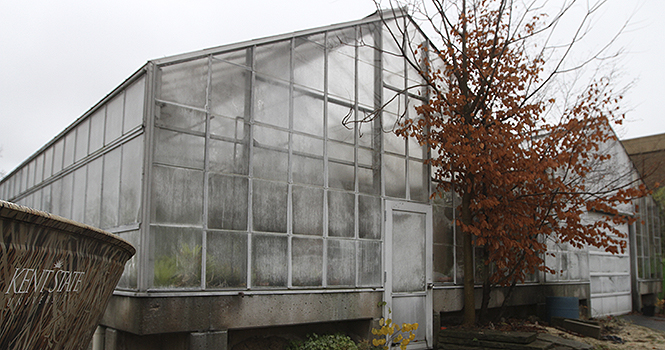Renovations to come for Kent State greenhouse
The Kent State greenhouse, located behind the library, is due for renovation, and a conflict of interest has come up while faculty members wait for the construction to begin. Photo by Chelsae Ketchum.
October 31, 2012
To a curious mind, the environment is immediately magnetic. Colors jump to the forefront of an observer’s attention as the eye roves to a maroon cactus sitting among neighboring plants from South Africa and Mexico. The scene is vivid and exotic in the Kent State greenhouse, which is home to a variety of plants from around the globe.
However, one cannot help but notice that the building, constructed in the 1960s with the rest of Cunningham Hall, is beginning to look like a “backyard experiment,” as one biology major fondly described it.
“It has a lot more potential, but students don’t do much with it,” said Laura Frear, a junior zoology major and Biology Club secretary, citing rundown conditions as one of the reasons for this lack of enthusiasm.
Due for renovation, the greenhouse is scheduled to be gutted and refitted with updated glass and other technologies in the next year, said Christopher Rizzo, Kent State’s horticulture faculty director.
This news signals the beginning of a complicated transition as the department tries to balance two conflicting visions for the greenhouse: experiments and research.
“We have existing research in our greenhouse that requires a nearly bug-free environment and a greenhouse that is soon to be overhauled,” Rizzo wrote in an email. “These issues really put the kibosh in our plans.”
He explained that experimental projects are currently halted in the planning stage until after the renovation.
This pause, while disagreeable to Rizzo, is necessary to biology researchers. Requiring the airtight sanitation of the updated building, Rizzo said, their work can only continue when renovations solve the complications currently created by the condition of the greenhouse.
“If it weren’t for the very restrictive requirements of research, we could get a biological balance going in no time,” said Rizzo, whose work does not demand the same pure conditions.
Rizzo has been working to perfect a largely self-sustaining project called “aquaponics” in which the nutrients from fish feces are used to prompt outstanding growth in plants. The plants then filter the water and continue the process, he said, which has become increasingly popular in the last two years.
Rizzo had planned to enlarge the experiment to include the whole greenhouse in a system involving a pond and new gravel beds. For the time being, these plans are currently stalled. But not all find this to be a chief concern.
“I’m sure it will interrupt some of the projects, but it will be a really good thing for research,” said Tori Ellis, freshman exercise science major. Excited for the renovations, Ellis said it was a stretch to find a room with conditions sanitary enough to conduct accurate research.
Ellis recalled that damage to a glass pane had once allowed a bee to enter a professor’s research room. Speculations her plant reproduction study may include distorted results became a significant concern.
“She just can’t tolerate that,” Rizzo said. “You really have to change the whole greenhouse design.”
The director explained that professors may face further troubles unless significant changes are made.
Such changes, however, are not unique to Kent State. As researchers and faculty realize the growing importance of “green” living, universities are working to develop their programs and save energy through renovations.
According to a newswire from the U.S. Federal News in September, Pennsylvania State University has been experimenting with the flexibility of LED lighting in an attempt to improve plant growth. Also, by installing the new lighting, the directors hope to become 90 percent more efficient while tackling such issues as a stable chamber temperature in greenhouses.
Efficiency will be one of the main focuses with the Kent State greenhouse as well, according to Rizzo. With the greenhouse energy conserved, routine maintenance decreased and research safe in newly pristine conditions, he would be free to explore the potential of the new building. “He has big ideas,” Frear said, adding that a butterfly room, netting for finches and an enlarged aquaponics experiment could be in the works.
It is clear, however, aquaponics will be the focus of his greenhouse efforts. Though it has yet to emerge as a popular system, a survey done by the Greenhouse Management periodical concluded that almost 62 percent of greenhouse operators are attempting to better monitor the water intake of their crops.
As conservation and new irrigation techniques rise to the forefront of attention among greenhouse managers, aquaponics may be a solution to an international need for sustainable agriculture.
In the meantime, these big ideas will hang in suspense with the multicolored vegetation, as both researchers and experiments await a brand new home.
“Everyone in our department would like to see something like this work,” Rizzo said.
Contact Hannah Kelling at [email protected].

























